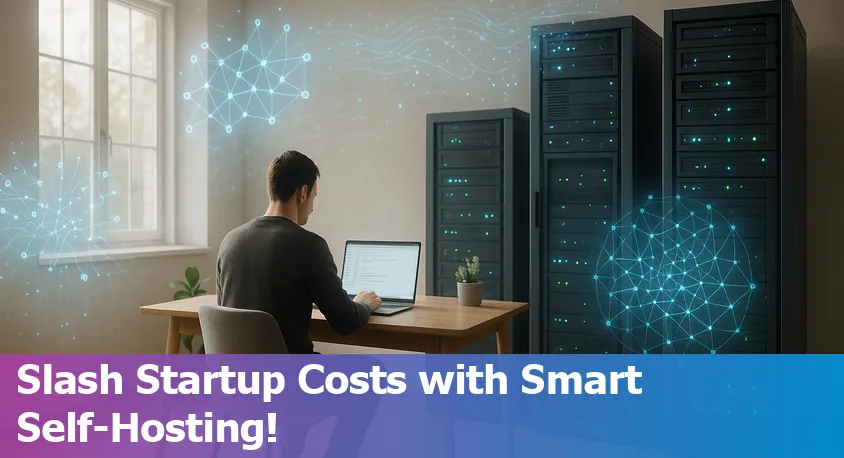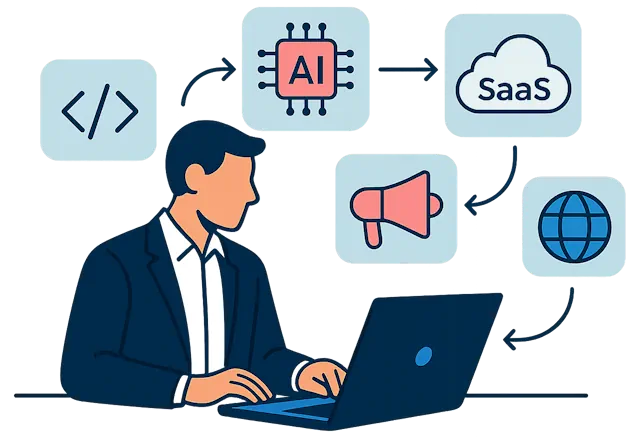Reducing Operational Costs Through Efficient Self-Hosting as a Solo AI Startup Founder
Last Updated: June 1st 2025

Too Long; Didn't Read:
Efficient self-hosting allows solo AI startup founders to cut operational costs - especially at high usage - by eliminating cloud fees, ensuring data privacy, and leveraging open-source LLMs like Llama 3.1. With up to 23x throughput gains via batching and potential 50%+ savings, self-hosting is now practical for scaling one-person AI companies.
The landscape of tech entrepreneurship is undergoing a profound transformation as artificial intelligence empowers a new generation of solo startup founders. Thanks to rapid advancements in generative AI, no-code development platforms, and open-source tools, it's now possible for one person to build, launch, and scale a company at a pace - and with a reach - that was once unimaginable.
As reported in Forbes, AI is opening the door to billion-dollar, one-person companies, with leading voices like OpenAI's Sam Altman predicting these “solopreneur unicorns” will soon become reality.
Research-driven platforms show solo founders today can replicate the productivity of entire teams, reshaping cost structures and investor expectations. Recent analysis highlights that the share of startups founded solo and without VC backing surged from 22.2% to 38% between 2015 and 2024, as noted in this deep dive on the new solo AI founder economy.
Yet, as success stories soar, experts caution about the unique challenges of working in isolation and the need to balance AI-driven efficiency with founder well-being and creativity - a message echoed in firsthand reflections from seasoned founders at Medium: Pitfalls of an AI-First Startup.
The rise of solo AI founders is not just a trend - it's fundamentally redrawing the map of possibility for ambitious builders everywhere.
Table of Contents
- Why Self-Hosting Lowers Operational Costs for Solo AI Startups
- Key Components of Self-Hosting: Hardware, Software, and Open-Source AI Models
- Essential Cost Optimization Strategies for Self-Hosting AI
- Overcoming Common Self-Hosting Challenges as a Beginner Solo Founder
- When to Self-Host Versus Rely on Cloud AI Services
- Proven Best Practices and Real-World Solo Founder Success Stories
- The Future of Self-Hosting AI for Solo Startup Founders
- Frequently Asked Questions
Learn step-by-step strategies for building a Minimum Viable Product with AI tools that can reach customers worldwide efficiently.
Why Self-Hosting Lowers Operational Costs for Solo AI Startups
(Up)For solo AI startup founders, self-hosting large language models (LLMs) can significantly lower operational costs, especially as cloud providers increasingly introduce complex, usage-based pricing and unpredictable token costs.
By running AI models directly on personal or on-premises hardware, founders eliminate recurring cloud subscription fees and gain full control over their data, crucial for meeting strict privacy regulations such as GDPR and HIPAA as detailed by TechGDPR.
However, cost efficiency is closely tied to usage patterns. According to an in-depth cost analysis, self-hosted models outperform cloud APIs in terms of savings when utilized at high capacity, but can become more expensive than APIs like OpenAI GPT-3.5 at lower utilization rates due to fixed infrastructure costs (see table below) as explained in ScaleDown's cost comparison:
| Pricing Aspect | Cloud AI Service (e.g., OpenAI) | Self-Hosted LLM |
|---|---|---|
| Pricing Model | Usage-based (per token) | Time-based (instance uptime) |
| Scalability | Pay more per use | Requires additional hardware for scaling |
| Cost Efficiency | Predictable at low-to-moderate volume | Best at high utilization/throughput |
Solo founders benefit from stable costs and avoid being affected by cloud vendor policy or price changes, gaining greater long-term financial predictability.
As summarized by VentureBeat, though self-hosting can carry higher up-front investment and operational complexity, it becomes economically viable once usage volume surpasses a critical threshold:
For most use cases, owning the model is not financially beneficial compared to using an API… [but] self-hosting makes sense when user request load far exceeds cloud costs.
For those comfortable managing their own infrastructure, self-hosting delivers substantial, compounding savings over time while maintaining full autonomy and compliance as outlined in VentureBeat's self-hosting analysis.
Key Components of Self-Hosting: Hardware, Software, and Open-Source AI Models
(Up)Establishing an efficient self-hosted AI stack as a solo founder involves carefully aligning hardware, software, and open-source large language models (LLMs) to your budget and technical requirements.
For hardware, recent guides recommend GPUs with at least 12GB VRAM for small to medium models, and advanced setups like 1x or 4x Nvidia A40 or A100 GPUs for running 70B+ parameter models such as Meta's LLaMA 3.1, with quantization (down to INT4/INT8) significantly reducing memory needs and costs.
Popular open-source LLMs, like Llama 3.1, Gemma 2, and Command R+, offer competitive performance and can be deployed using robust tools such as Ollama, vLLM, or LM Studio - each varying in ease of use, performance, and features.
The following table summarizes top tools and LLMs relevant for solo founders:
| Tool/Model | Best Use | Ease of Use | Performance | Model Size (B) |
|---|---|---|---|---|
| Ollama | Integrations, Local Dev | Medium | Medium | Supports 7B–70B |
| vLLM | Production, High-Performance | Low | High | Supports 7B–70B+ |
| LM Studio | Beginner-Friendly, Local Demo | High | Low | Supports 2.7B–70B |
| Llama 3.1 | General Assistant, Coding | – | – | 8B, 70B |
| Gemma 2 | Instruction, Reasoning | – | – | 9B, 27B |
Leveraging these open-source models and tools enables strong privacy, control, and cost-effectiveness, with many founders using approachable platforms like Ollama on modest hardware such as a Mac Mini, or scaling up with multi-GPU servers in the cloud.
As one solo practitioner shared:
“We just use a cheap M4 Macmini which hosts multiple models via Ollama, works good enough for our usecase.”
Explore step-by-step deployments and model performance insights in this comprehensive guide to self-hosting LLaMA 3.1 affordably, review the most promising open-source models for 2024, and compare the leading self-hosting tools and their strengths at this LLM VRAM calculator and self-hosting resource.
Essential Cost Optimization Strategies for Self-Hosting AI
(Up)Solo AI startup founders can dramatically lower operational costs and boost self-hosted AI performance by deploying a blend of model compression, low-bit quantization, advanced batching, and intelligent caching strategies.
As highlighted in the Deepsense.ai LLM inference optimization guide, cost-saving begins with distillation (training compact student models from large teacher models), offering vast memory savings and up to 10× lower hardware expenses, with only a modest drop in accuracy.
Quantization (e.g., converting 32-bit floats to 8-bit or 4-bit integers) further reduces model size and speeds inference, sometimes doubling or tripling throughput while minimizing memory requirements.
For real-time workloads, continuous batching can increase GPU utilization and throughput up to 23-fold versus static batching, as proven by frameworks like vLLM and Anyscale, while KV/prefix caching - which reuses attention computations across requests - enables faster text generation and reduced compute for repeated or overlapping prompts.
The table below summarizes the primary trade-offs of these strategies:
| Technique | Benefits | Trade-offs |
|---|---|---|
| Distillation | Lower memory & cost, fast inference | Minor accuracy loss |
| Quantization | ~2× speedup, 2–4× memory reduction | Possible quality drop if precision <4-bit |
| Advanced Batching | 23× throughput, lower p50 latency | Higher per-request latency under load |
| Prefix/KV Caching | Faster long-text generation | Increases memory use |
For maximal efficiency, combine these tactics - optimize your serving infrastructure, leverage open-source toolkits, and integrate memory management enhancers like PagedAttention or advanced prefix caching frameworks.
As one expert notes,
“By 2025, prefix caching has cemented its place as a cornerstone of AI efficiency, enabling significant performance improvements for real-time applications.”
To learn more about these methods and see real-world benchmarks, review in-depth breakdowns from Anyscale's continuous batching report and the Modular team's guide to boosting LLM performance via prefix caching.
Overcoming Common Self-Hosting Challenges as a Beginner Solo Founder
(Up)Beginner solo founders often encounter several hurdles when choosing to self-host AI solutions, but these challenges are surmountable with the right strategies and community support.
Technical complexity and a steep learning curve are common - the initial setup requires understanding hardware, operating systems, and containerization with tools like Docker or Proxmox, as well as configuring secure networks and maintaining regular updates.
See Self Hosting 101 - A Beginner's Guide. The operational landscape also demands selecting appropriate hardware - GPUs with at least 12GB RAM are often recommended for modern AI models, while CPUs and storage must also be up to par for inference and fine-tuning tasks.
Learn more in this comprehensive AI stack walkthrough. Beginners commonly struggle with issues such as model compatibility, security measures, ongoing maintenance, and troubleshooting obscure errors; joining self-hosting communities and starting with smaller, single-purpose models and services like Ollama or Home Assistant can dramatically flatten the learning curve.
Explore lessons learned from fellow self-hosters at Selfhosting AI Models: Lessons Learned.
As one self-hoster summarizes,
“Break things. Fix them. Break them again. You'll learn more in a weekend than a month of tutorials.”
Adopting these incremental, hands-on tactics not only builds confidence but also turns operational pitfalls into growth opportunities for solo AI founders.
When to Self-Host Versus Rely on Cloud AI Services
(Up)Deciding when to self-host AI models versus relying on cloud-based AI services is pivotal for solo startup founders focused on operational efficiency. Self-hosting shines for high-volume, business-specific tasks where custom fine-tuning, privacy control, and predictable long-term costs are paramount - Infocepts reports their self-hosted models reached 85–90% accuracy (versus 70% with APIs) at about $1,000–$1,500 per month for 0.5–1M daily tokens, compared to much steeper API bills at scale.
However, cloud AI APIs are ideal for early-stage products, low or irregular usage, or when infrastructure resources and MLOps expertise are limited - platforms like OpenAI and Google Gemini offer pay-as-you-go flexibility and seamless scaling, making rapid prototyping and market validation easier (LLM Inference as-a-Service vs. Self-Hosted: Which is Right for Your Business).
The choice is also driven by compliance: self-hosting keeps sensitive data in-house for regulated industries. Here's a concise comparison:
| Aspect | LLM-as-a-Service | Self-Hosted LLMs |
|---|---|---|
| Costs | Low upfront; efficient for low/irregular traffic | Higher initial investment; cost-effective at high volume |
| Scalability | Automatic, robust scaling | Manual or cloud-based scaling; requires expertise |
| Customization | Limited to provider models/features | Full freedom to fine-tune and optimize |
| Security/Compliance | Shared responsibility, possible data exposure | Complete data control |
As detailed in LLMs – Self-Hosting or APIs? The Million Dollar Question, enterprises increasingly blend both methods - APIs for rapid, generic features and self-hosted solutions for proprietary or cost-sensitive operations.
Ultimately, solo founders should map predicted usage, data privacy requirements, available expertise, and feature needs to select the best mix, iterating as their product and user base evolves (AI API Price Compare: Find the Best Deals in 2025).
Proven Best Practices and Real-World Solo Founder Success Stories
(Up)Solo founders are redefining what's possible in the AI sector by leveraging efficient self-hosted strategies to launch competitive products without large teams or major funding.
In 2024, the percentage of founders working alone doubled compared to 2017, with success stories like Bhanu Teja's SiteGPT - which reached $15,000 in monthly revenue within months - and Samanyou Garg's Writesonic, which scaled to over 10 million users, showcasing the cost-efficiency and agility enabled by self-hosting and open-source AI tools (Solo AI Founder market trends and real-world examples).
Writesonic's case studies reveal that using self-hosted AI models can slash content creation costs (sometimes by over 50%), increase output, and remove dependence on extensive training or dedicated marketing teams - a sentiment echoed by their CEO:
“Writesonic helped us cut our content costs in half while actually improving quality. What used to take a team of 7 people, we now accomplish with a team of 4 - and we're seeing better results.”
(AI-powered content creation case studies).
Best practices emerging from successful solo founders include choosing open-source LLMs like Llama or Mistral, optimizing deployments for privacy and resilience with tools like Docker and Milvus, employing batching and prefix caching for major cost savings, and rigorously monitoring operations to avoid vendor lock-in and maintain regulatory compliance.
The following table highlights core optimization techniques that solo founders have adopted for high-performing, cost-effective self-hosted AI deployments:
| Technique | Benefit |
|---|---|
| Batching & Token Streaming | 23x higher throughput; lower latency |
| Prefix Caching | Up to 90%+ cost savings |
| Quantization & Model Parallelism | Lower resource use; faster response for large models |
These strategies, validated by both founders in practice and experts in AI orchestration, are central to keeping operational costs low while scaling as a one-person company (Technical guide to LLM self-hosting strategies).
The Future of Self-Hosting AI for Solo Startup Founders
(Up)The future of self-hosting AI for solo startup founders is set to be profoundly shaped by open-source technologies and AI-driven workflows, breaking the traditional need for large teams and heavy investment.
Open-source AI models and platforms, such as Llama 2 and Hugging Face, are democratizing access to advanced capabilities, empowering founders to build, customize, and scale AI products with full control over their data, privacy, and compliance - often at a fraction of legacy costs.
As Forbes notes, these solutions not only provide enhanced data sovereignty but
“could parallel the success of Linux” in enterprise ubiquity, allowing solo founders to adopt phase-wise, risk-aware AI strategies for sustainable growthas explored in their analysis of open-source AI's future impact.
Industry experts now anticipate the rise of billion-dollar solo ventures, with OpenAI's Sam Altman and Tim Cortinovis highlighting that
“you don't need a full-time staff anymore - just the right problem to solve and the right mix of AI tools and freelancers”in Forbes' solo entrepreneurship report.
Meanwhile, communities like Bonanza Studios showcase that bootstrapped, high-margin SaaS businesses run by individuals leveraging AI can yield substantial, sustainable profits - often exceeding those of VC-backed ventures - by harnessing scalable automation, targeted subscriptions, and a lean operational footprint as detailed in their feature on thriving solo founders.
In essence, the next wave of solo AI founders will be those who adopt open innovation, rapidly leverage advances in open-source frameworks, and prioritize business agility - making now the prime era for entrepreneurial self-starters to seize the AI opportunity.
Frequently Asked Questions
(Up)How does self-hosting AI models reduce operational costs for solo startup founders?
Self-hosting AI models eliminates recurring cloud subscription and API token fees by running models on personal or on-premises hardware. This can result in significant savings at high usage volumes. While self-hosting has higher upfront costs and requires technical effort, it provides predictable long-term expenses, control over data for compliance, and autonomy from cloud vendor pricing changes.
What hardware and software are needed for efficient self-hosted AI as a solo founder?
Efficient self-hosted AI requires GPUs with at least 12GB VRAM for small-to-medium models, or advanced multi-GPU setups for large models. Recommended open-source models include Llama 3.1, Gemma 2, and Command R+, which can be deployed using tools like Ollama (for integrations and local development), vLLM (for production and high performance), or LM Studio (beginner-friendly). Model quantization and batching frameworks are also essential for cost and memory efficiency.
What are the key cost optimization strategies for solo founders self-hosting AI?
Key strategies include model distillation (to reduce memory and hardware requirements), low-bit quantization (to cut RAM use and speed up inference), advanced batching (to maximize GPU throughput), and prefix or KV caching (to reuse computations and lower compute time for repeated prompts). Combining these reduces total costs and improves performance for self-hosted AI workloads.
When should a solo AI startup founder choose self-hosting over cloud-based AI APIs?
Self-hosting is ideal for high-volume, business-specific workloads where custom fine-tuning, privacy, and long-term savings matter most. It provides full data control and predictable costs at scale. Cloud APIs are better for early-stage products, low or irregular usage, or when the founder lacks infrastructure experience. Many startups use a hybrid approach, combining APIs for prototyping with self-hosted models for scaling specific features.
What challenges do solo founders face with self-hosting AI, and how can they overcome them?
Solo founders face technical complexity, a steep learning curve with hardware and containerization, and challenges around model compatibility, security, and maintenance. These can be overcome by starting with smaller models and beginner-friendly platforms (like Ollama), engaging with support communities, and incrementally building infrastructure know-how through hands-on experimentation.
Supercharge discoverability by effectively localizing keywords and app descriptions tailored for each target language.
Uncover the best beginner-friendly coding platforms that make vibe coding accessible to everyone starting their AI journey.
Discover the essential strategies behind email marketing for solo AI founders and why it's a must-have tool for startup growth.
Level up your workflows with self-hosted automation plugins for AI startups that rival SaaS competitors - minus the ongoing fees.
Streamline regulatory audits with AI supply chain documentation best practices that keep your tech stack transparent and verifiable.
Explore how a cost-effective marketing tool like Mautic can keep your customer acquisition budget under control.
Scale confidently with your solo AI startup thanks to MotionPoint's enterprise-ready proxy solution for rapid website localization.
Protect your startup's sensitive files and data with secure legal AI workspaces specifically designed for independent founders.
Ludo Fourrage
Founder and CEO
Ludovic (Ludo) Fourrage is an education industry veteran, named in 2017 as a Learning Technology Leader by Training Magazine. Before founding Nucamp, Ludo spent 18 years at Microsoft where he led innovation in the learning space. As the Senior Director of Digital Learning at this same company, Ludo led the development of the first of its kind 'YouTube for the Enterprise'. More recently, he delivered one of the most successful Corporate MOOC programs in partnership with top business schools and consulting organizations, i.e. INSEAD, Wharton, London Business School, and Accenture, to name a few. With the belief that the right education for everyone is an achievable goal, Ludo leads the nucamp team in the quest to make quality education accessible


